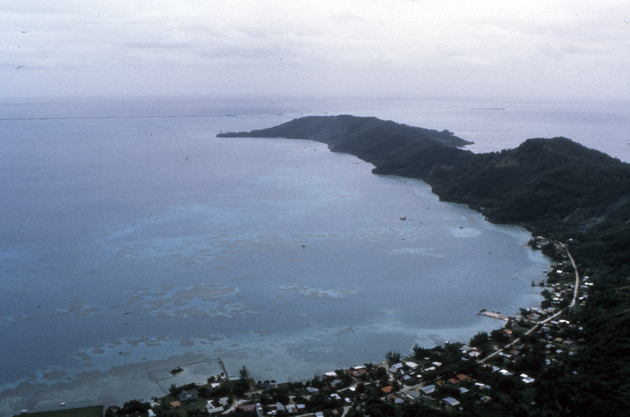Voyage to Rapanui
Leg 2. Nukuhiva to Mangareva (July 31-August 30, 1999)
Navigator: Chad Baybayan, with apprentices Moana Doi and Catherine Fuller.
Summary: Before departing for Mangareva, Hokule‘a visited the six main islands of the Marquesas.
She departed for Mangareva on August 14. To avoid the dangerous atolls and reefs of the Tuamotu Archipelago, Hokule‘a took a tow from the escort boat Kamahele on a SE by E course for 660 miles. The navigators aboard Hokule‘a, not using instruments, directed the Kama Hele via radio.
The original sail plan was for Hokule‘a to drop the tow at about 16 degrees S, 130 degrees W and begin sailing south to 25 °S to look for land-based sea birds around the triangle of Oeno, Pitcairn, and Henderson. After finding one of these islands, the crew would sail westward, looking for land-based sea birds around Mangareva.
Once Hokule‘a reached the target point where it planned to drop its tow, however, navigator Baybayan decided to continue to tow: the light winds, three extra days in the Marquesas, and a tight schedule requiring the canoe to be in Mangareva by the first week of September for the leg to Rapa Nui made the towing necessary.

Reports on the Interisland sails (July 31-August 13) through the Marquesas by Dennis Kawaharada.
Before departing for Mangareva, captain-navigator Chad Baybayan took us on a tour of the six main islands of the Marquesas.
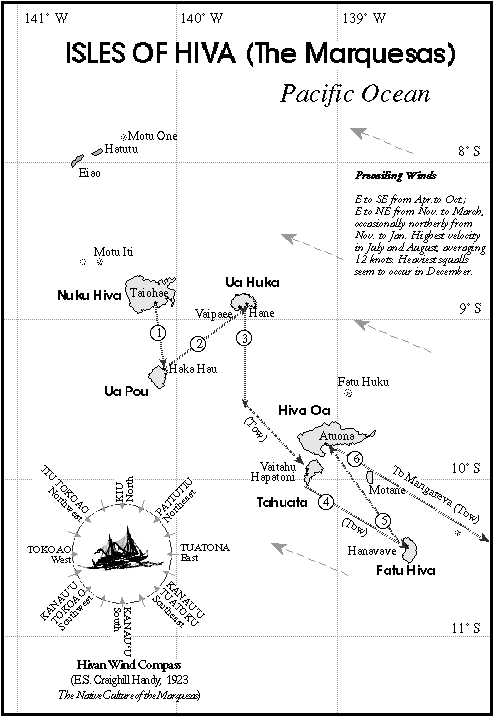
July 31
Taiohae, Nukuhiva--The Hokule'a crew for the leg to Mangareva arrived safely at Nukuhiva Airport, July 26. Met by Tava Taupu, T. Hee, et al, from the first crew. Greeted by Marquesan schoolchildren at a summer camp in the hills above the airport. Songs and dances; bananas and grapefruit were ono.
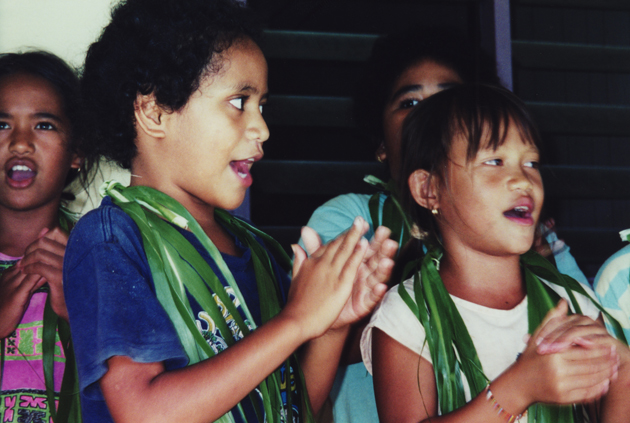
Tava, a native of Taiohae, pointed out two kuku, an endangered native pigeon, flying across the valley. Hills are being planted with pines for forestry, replacing the native flora, one tree akin to Hawai'i's 'ohi'a lehua. 3-hr drive overland on dirt and rock road to Taiohae, across mountains and central plateau called Tovii.
From the heights of Mouake, the road winds down to the U-shaped bay of Taiohae, opening to the south, with Ua Pou on the horizon, 20 miles away. Hokule'a anchored on the west side of the bay.
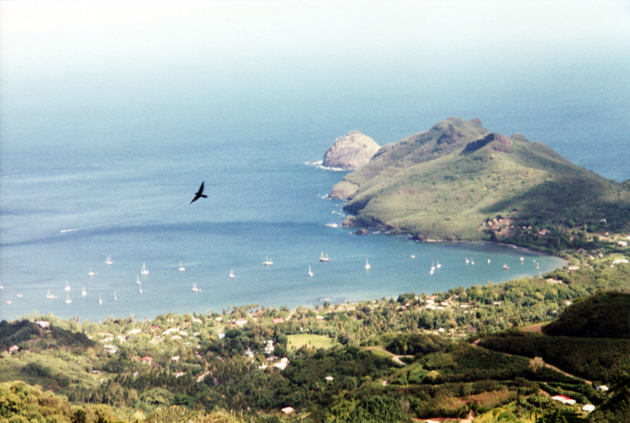
Days passing swiftly before departure on Aug 2: Redoing battens on canvas sleeping compartments, esp. the two nicknamed "the Swamp" and "Niagra Falls" on the first leg. Batteries for radio and running lights not recharging; Aldon Kim working on the eletrical system. G. Yuen. Mona Shintani, and Mel Paoa made a new toilet seat for the canoe.
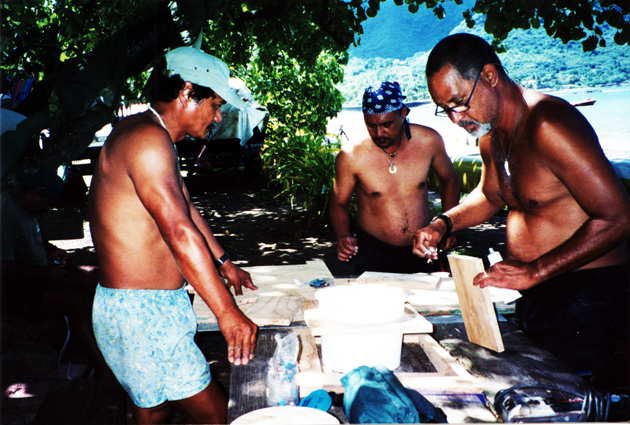
The canoe is in top shape, thanks to the first crew. July 29: loading water and supplies under Moana Doi. July 30: on board training under Captain/Navigator C. Baybayan. July 31: prep for thank-you paina on Aug 1, with imu and kalua pig.

Russell, Maka, Aldon, Mona, and Desmond cooking
Multilingual camp set up at a paddling canoe club house: Marquesan, Hawaiian, English, and French spoken. Mona, from Ni'ihau, talking Hawaiian in his sleep. Nukuhiva canoe club training for the paddling race across Hawai'i's Kaiwi channel. Watched action video by M. Attwood of the voyage to Nukuhiva, scenes of crew under Bruce Blankenfeld catching an ono, searching for land to the west, turning around, sighting Eiao in the morning rain squalls. July 28: celebrated crew member G. Suzuki's birthday with barbequed goat, a Marquesan delicacy. Crew members T. Gilliom, R. Amimoto, and K. Hoe helped pack out the goat, shot last week by Kimitete Kamehameha and another Marquesan at a remote valley on the north side.
Cultural exchanges: D. Anton and M. Attwood teaching a Hawaiian song and a chant to children at the school next to the canoe club. Maka carving stones to present as gifts to the school next door and the Nuku a Hoe canoe club. Three crew members (Gary Y., Tim, and Russell) have new Marquesan tatoos.
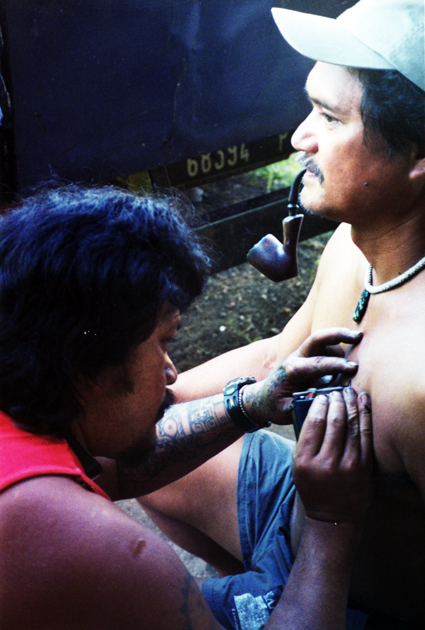
Tava took C. Fuller, K. Akaka, and D. Kawaharada on a journey through his childhood and family traditions in the valley of Pakiu, K. recording it on video. Walked up a six-foot wide stone path, the ancient road that ascends up a ridge to Mouake pass and across the central plateau to all parts of the island. Paepae (stone house foundations) line the trail. Stopped at the me'ae (temple) and tohua (dance plaza) of Pakoko, famous Marquesan warrior and ancestor of Tava, four generations ago. Pakoko led the Marquesan resistance to the French during his time.
Tava stopped to show use the stream where Pakoko threw down the bodies of slain French sailors who had raped his daughter:
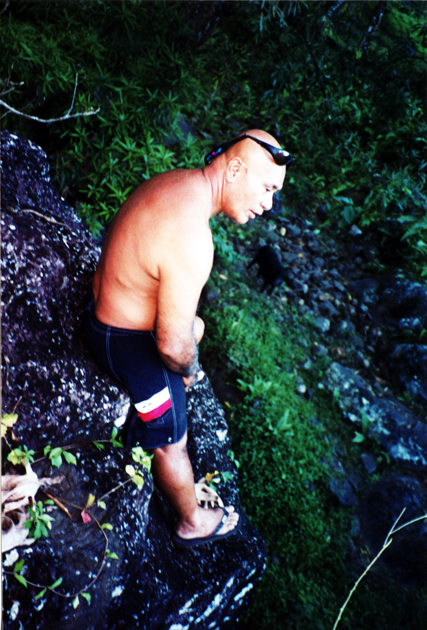
Pakoko was executed by a French firing squad in 1845 for having allegedly ordered the killing. The family in Taiohae still remember his execution with bitterness. When thunder rolls, they believe it is a sign that Pakoko is returning.
August 2
Taiohae, Nukuhiva--Departure of Hokule'a to Hakahau, Ua Pou, was delayed till midnight tonight. An ARGOS transponder for tracking the canoe and a charger for a Betacam that will be used to document the voyage came in on a flight from Pape'ete to Nukuhiva yesterday but got stuck at the airport after the delivery truck broke down.
The airport closes down for the night and does not open till the next flight comes in at 11 the following morning. Ro'o Kimitete, the mayor of Taiohae, was going out to the airport to pick up his wife Deborah, who was returning from Pape'ete, so he offered to pick up the equipment for us this morning.
Our camera man Hugh just came out to the escort boat Kamahele with the charger in hand...so it made the 2.5 hour journey over the mountains safely. It's too late to depart for Ua Pou now...the five hour sail would take us into the harbor of Hakahau at nightfall...a dangerous maneuver in an unfamiliar place. So Captain/Navigator Baybayan decided to sail at midnight and arrive at the harbor at dawn. The new plan is a plus for the crew, as we will be sailing at night under the stars--a good time to orient the new crew members to navigating by celestial bodies.
The nights have been mostly clear, with passing trade wind clouds... full of star, the Milky Way stretching from the Southern Cross setting in the west to Vega and Altair rising in the east... Musca, the Pointers, Atria in the Southern Triangle, Maui's Fishhook (Scorpio), and the Peacock in the Southern sky, which is fully visible (mountains surround Taiohae on the east, north, and west). The Milky Way is known as the Shark in some parts of Polynesia and Maui's fishhook is set in it.
The navigators have been studying their southern pointers...pairs of stars that point to the South Celesital Pole, which is 9 degrees above the horizon in Taiohae (but below the horizon in Hawai'i.)
Plan is to pull two of the three anchors at 4 p.m.today, have dinnner at 6 (final farewells) and rest on the canoe before getting under way at midnight, when the last anchor will be pulled. The crew members who have been here since the canoe got in three weeks ago have been adopted into the community and feel like they are leaving home again. Many thanks to the Nuku a Hoe canoe club for hosting us at their club house and the rest of the community of Taiohae for all their support. The crew has been well taken care of.
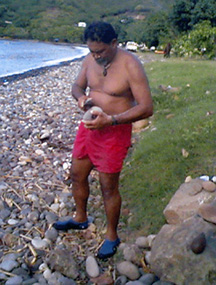
Maka Carving a Stone Pestle on the Beach at Taiohae. He presented the pestle as a gift to Nuku a Hoe for hosting the crews of Hokule'a and Kamahele.
Winds have been easterly trades at 10-15 knots for the whole week. Today the winds were E by S, a good wind to get us to Ua Pou.
The new plan (ever changing) is to stay in Ua Pou until 10 p.m. tomorrow, then depart for Ua Huka on another night sail. Arrive at Ua Huka the next day at dawn and spend the day there. Depart for Tahuata at 4 p.m.
Captain Baybayan has been invited by the mayor of Vaitahu on Tahuata to visit, so we will be anchoring there rather than at Hana moe noa. The village of Vaitahu has a canoe building project going. The rest of the schedule remains the same, with a stop at Hanavave, Fatu Hiva, on August 6, before arriving at Atuona, Hiva Oa on Saturday, August 7.
August 4
Hane, Ua Huka--Hokule'a arrived at 11 a.m. this morning in this small bay on the southern coast of the easternmost island of the northern Marquesan group. The bay opens into small valley, filled with a small village and coconuts palms up to steep pali at the back.

The bay at Hane
We were greeted by Leon Lichtle, the mayor of Ua Huka, and given a tour of the southern coast. The island looks like a large crater, half of which has fallen into the ocean, the northern rim still intact.
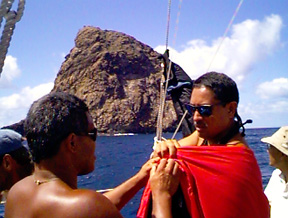
Kealoha Hoe Assists Protocol Officer Kaniela Akaka with his kihei.
A group of dancers performed a dance of canoe building and a song praising the valleys of the island. We will be departing early this evening, perhaps before sunset, for Tahuata in the southern Marquesan group, 65 miles away.
A voyage is a lei of greetings and farewells. Two nights we left Taiohae. The mayor Ro'o Kimitete and his wife Deborah came to say farefwell. Ro'o did a chant honoring Tanaoa god of the ocean. The crew was presented with tiare leis, then departed to sleep on the canoe. Most the the crew members gave their leis to the canoe, realizing that it is not the individuals that are honored, but Hokule'a. It was a time to reflect on all who have sailed her over the last 25 years, who have made her great and famous throughout Polynesia, particularly the crew of the first voyage, who had ventured out into the unknown with navigator Mau Piailug. It's hard to believe a generation has passed...crew member Mona Shintani is the nephew of the first captain Kawika Kapahulehua. Deborah recalls that she was in France when Hokule'a first arrived in Tahiti, but her father told her about the arrival, and she saw the photographs of the thousands who came out to see the canoe.
We left Taiohae Bay at 4 am so that we would arrive in Hakahau, Ua Pou, at about 10 a.m. for a welcome ceremony.

This island is famous for its spires of stone that rise hundreds of feet from the mountain ridges and summits above the town...no other sight like it in the world.

Ua Pou means "Pillars" or "Posts," i.e. posts used to build a house. The central peak of Ua Pou, usually clouded, is called Te-Ava.
The leader of the dance group that greeted the canoe, Petrano Toti, took the crew on a short tour of the island, south of Hakahau...to the valley of the king...a place that was kapu after the first and only king of Ua Pou died. He was considered a god so after he died, no one could live in the valley...the paepae of his house is still intact, a large stone platform in the middle of the bushes off the side of the road.
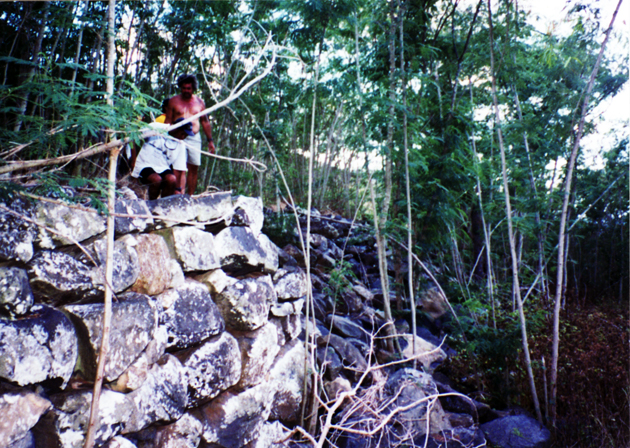
The large paepae (stone foundation and floor of a traditional Marquesan House) of Te-iki-tai-uao, chief of the Ati Papa tribe of Haka Moui, who secured control of the whole island of Ua Pou. After his death in 1860, the valley was kapu, for the chief was thought to be a god...no one lived there for a century.
On the way back to the harbor, Petrano cut some cooking bananas for the crew at his family plantation in the hills above Haka Moui, The Valley of the Chiefs. The bananas grow straight up, at the top of the plant.
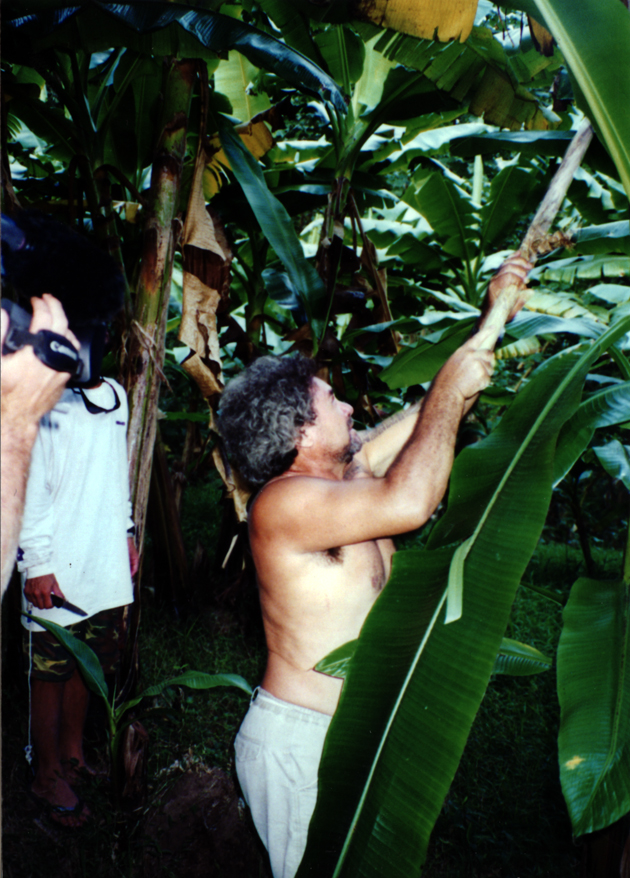
Toti was quite a storyteller: he told of Makaianui, the pig demigod, of the Marquesas, and how once when the islanders were starving, a tuhuna called out to the pig god and he arrived with aku all over his body, having bitten his bristles. He shook his body and the aku fell off, to feed the people. The pig god himself sacrificed his own body to feed the people as well.
A text of this legend can be found in "Von den Steinem's Marquesan Myths"--the story of Akaui (pp. 32-35):
Aka-ui (Polynesian: Raka, the wind god; Hawaiian: La'amaomao) lives at Hanapaaoa, on the north side of Hiva Oa. He goes to Ua Pou and exchanges names (becomes friends) with Toa'etini ("Many Tropic Birds"; Hawaiian "Koa'e-kini"). But Toa'etini has no pork to offer him...the pig in the imu has already been eaten, only the skull is left. (In the oral version we got on Ua Pou, the storyteller says Toa'etini boasted that he could bring a pig back to life from bones...i.e., that it would have flesh on it; but when the imu was open, the people found only bones.) When Toa'etini calls on his birds to bring fish and water and his rat to bring kava, Akaui kills the birds and the rat to humiliate his host (because his host cannot provide for his guest). Then he tells Toa'etini that his pig Manaiaanui (Makaiaanui on Nukuhiva) is well fed. He tells Toa'etini to chop wood and dig an imu. Then he calls out to Manaiaanui in Hanapaaoa on Hiva Oa. The pig swims across the ocean to Ua Pou. "Flocks of birds and fishing boats follow the swimming pig and the sea moves like a school of bonito fish [aku]." (32; in the oral version we got on Ua Pou, the storyteller says, "The pig's body was covered with aku; when he shook his body, the fish fell off. Compare Toa'etini inability to provide fish for his guest.)
When Manaiaanui arrives, Akaui tells him to die, and the pig dies and is cooked and eaten. Akaui takes the head, the choicest part, another humiliation to his host. When Akaui takes up his kava cup, Toa'etini tries to get even by telling the daughters of Pahua-Titi to piss in Akaui's cup as they swing from a pua tree on Te-Ava, the central peak of Ua Pou. Akaui sees them pissing in his cup and throws his cup away. Angry, he sends two of his warriors back to Hanapaaoa to get two stone balls. When they return, he calls for kava again; when the girls try to urinate in his cup again, his warriors hurl the stones at the branch they are swinging from, the branch breaks, and they fall to their deaths. Then Akaui returns to Hanapaaoa and weeps for his pig.
Editor Jennifer Terrell interprets this story as a nature allegory: Aka-ui, the wind god, brings pigs (metaphorically life-giving rain clouds) on the ESE trade winds from Hiva Oa to Ua Pou, particularly during the winter wet season; Toaetini represents the dry season, when there is less food available; the two girls are the clouds that hover at the tops of the mountains and sprinkle only lightly.
Crew member Tava Taupu told me on the sail to Ua Huka, that the story of Makaianui explains the mana of pig bristles tied onaku lures. The aku somehow are attracted to it. Aku lures in both Hawai'i and the Marquesas have pig bristles on them.
August 6
Vaitahu, Tahuata--Hokule'a is anchored this morning, Friday, Aug. 6, in Vaitahu, a small bay and village on the leeward side of Tahuata, the smallest populated island in the Marquesas, with 19 sq. miles and 600-700 inhabitants.
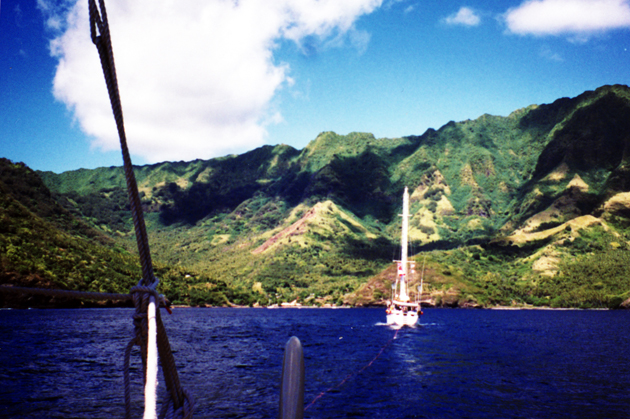
We left Hane, Ua Huka, at 6 pm yesterday; the projected 13-hour sail to Tahuata turned into a 20.5-hour sail and tow. During the night, the canoe made a course of Hema (South) and was set 32 miles WNW of Tahuata by the ESE tradewinds and the west-flowing current. We picked up the tow from escort boat Kamahele at 6 am and were towed for 8 1/2 hours, into Vaitahu, anchoring at about 2:30 pm yesterday.
We were greeted by the mayor and a dance and drum group of schoolchildren; had an excellent meal at the mayor's house--raw and cooked fish, raw and cooked a'ama crab, pork, chicken, breadfruit, kalo, etc. Spent the night on the canoe. A strange wind gusted out of the valley all night, apparently coming over the steep mountains in the back. The shade-rain tarps flapped wildly each time a gust blew. The bottom of the bay is steep so anchors do not hold well. The crew had to reset the anchors at 3 am this morning. Today the crew will tour the town and then go in boats to visit Hapatoni valley a few miles down the coast.
The bay of Vaitahu is rich in fauna. Just offshore as we approached, we saw piles of aku birds off the starboard side. Fisherman Terry Hee landed some aholehole and akule from the canoe last night with a light rod and reel. Gary Yuen fried them for breakfast-ono! Some ulua were swimming around the canoe last night, as well as the ubiquitous mano (shark). (Tava says that the Marquesans never swim for recreation as the waters around all the islands are shark-infested, but fishing from canoes and boats and diving are part of the people's livelihood.) A school of porpoises feeds in the bay--they look smaller and darker than the porpoises in Hawai'i. This morning, while we were preparing breakfast, a lone 'iwa bird soared above, fishing the bay...He dropped his fish in mid-air then swooped down to catch it in its sharp beak again...Tava said the 'iwa did this to kill the fish.
Captain Baybayan plans to depart this afternoon before sunset.
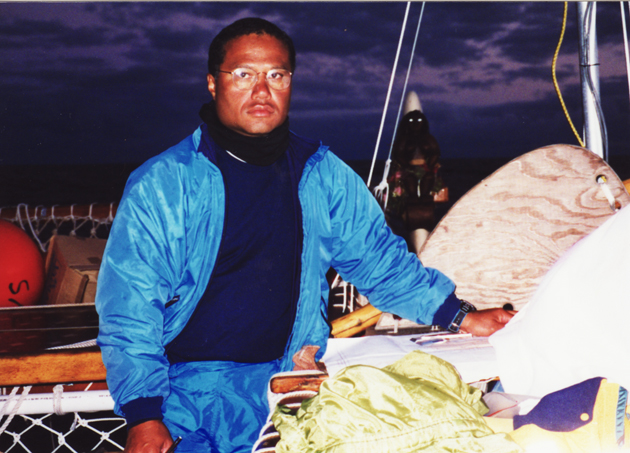
Chad Baybayan
Makanani Attwood will present the mayor with a stone petroglyph of the canoe when we depart this afternoon. We will arrive tomorrow morning in Fatu Hiva, the southernmost of the Marquesas islands and spend a day there, then depart before sunset for Hiva Oa, our final stop in these emerald mountains rising out of the sea. We should arrive in Hiva Oa on Sunday morning.
NOTES ON UA HUKA: the bay of Hane where we landed on August 4 was where Dr. Sinoto found pottery fragments from an early Polynesian settlement, c. 250-300 AD. It is the earliest archaeological site in the Marquesas. The road along the southern coast runs from Hane to Vaipaee, winding around the steep sea cliffs (with no guard rails!). The landscape is mainly dry grasslands, where wild horses and goats roam, cut through by lush green valleys where rivers run down from the northern mountains. On the way to Vaipaee we stopped at a botanical garden with plants from all over the world. Mayor Lichtle said they were experimenting with the plants (e.g. orange trees) to find those that grow well for commerical purposes on Ua Huka. In Vaipaee, we visited a museum which displayed some original and some reproductions of Marquesan artifacts.
August 8
Atuona, Hiva Oa--Hokule'a anchored in Atuona at 4:30 HST after a sail up from Hanavave, Fatu Hiva. We left Hanavave at 7 am this morning. The winds were 10-12 knot easterlies until we were abreast of Terihi, a small jagged island off of Mohotani, when a squall hit. We closed sails until the squall passed, then continued on with better winds.
The canoe left Vaitahu, Tahuata, two days ago (August 6) at 5 pm. Hokule'a was towed by Kamahele down the leeward coast of Tahuata, close to shore, so the crew could say goodbye to the people of Hapatoni, a village they had visited earlier in the day. The sun was setting in a cloudless, deep blue sky. The spires of Ua Pou were visible one house north of the sun, like little fingers protruding from the horizon.

Ua Pou on the Horizon. The ki'i kane (male god) on the starboard side of Hokule'a.
A flock of about 30 noio (noddy terns) appeared, flying out of the sun, returning home; 'iwa (frigate birds) circled above the steep mountainside covered with hau, coconut, mango, banyan and a few albizzia trees, their vibrant greens tinged with orange sunlight. A few goats climbed a cliff. Our hunter Aldon Kim swore one day he would be back for them.
Earlier in the day the crew had gone by boat to Hapatoni, which is situated on a narrow strip of land beneath the cliffs. The village has no cars and there is no road in. The crew was greeted by the children of the school with dances and a meal of fish and fruit.
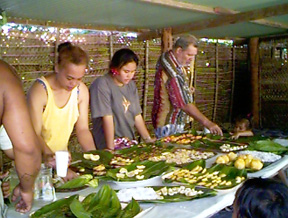
"The Best Meal Yet," said crewmember Kealoha Hoe after the crew's visit to Hapatoni, along the coast of Tahuata south of Vaitahu. "It was all from the land and sea--fruits and fish." The food was served on leaves.
The newly-formed Hokule'a dance troupe (M. Doi, C. Fuller, N. Wilson, and A. Polo), with musicians K. Akaka and D. Antone, responded with "Hi'ilawe" and "Aloha Kaua'i." In the village, Mel Paoa met more of the Paoa family that has spread throughout Polynesia.
As Hokule'a approached Hapantoni at sunset, M. Attwood, K. Hoe, and K. Akaka let loose some blasts of their pu (conch) and the children and parents came out to wave goodbye.
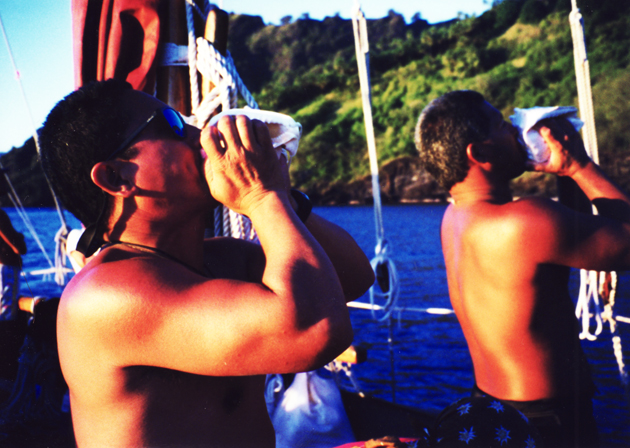
Tava Taupu stood on the navigator's platform and started shouting: "Aloha nui! I love you! Kaoha nui ia outou! Eo Nukuhiva! Eo Vaitahu! Eo Hapatoni! Eo Hawai'i!"

Tava has been rejuvenated by his visit to his homeland. Earlier in Vaitahu he met a childhood friend. When he left in the sixties there were no cars and airplanes, only horses and boats. "Aloha nui! I love you! Kaoha nui ia outou!" he shouted again, one arm raised and waving goodbye. His voice echoed and faded in the darkening mountainside. We were towed out of sight of the villagers.
When we turned the southern end of Tahuata, the wind and seas came at us again. Hokule'a towed through the night to Fatu Hiva, tacking there a too time-consuming exercise for its tight schedule. We approached the island before dawn under a waning crescent moon, anchors down by 8 am. The small bay is spectacular, with huge monolithic stones towering overhead on three sides.

Fatu Hiva,the southernmost island of the Marquesas, has even fewer people than Tahuata--about 300.
Fatu Hiva
No one told the villagers we were coming, but they were happy to host Hokule'a and Kamahele. The children and their parents began lining the shore. The women brought flowers and leaves and began making waist bands, head dresses, and lei for a dance performance.
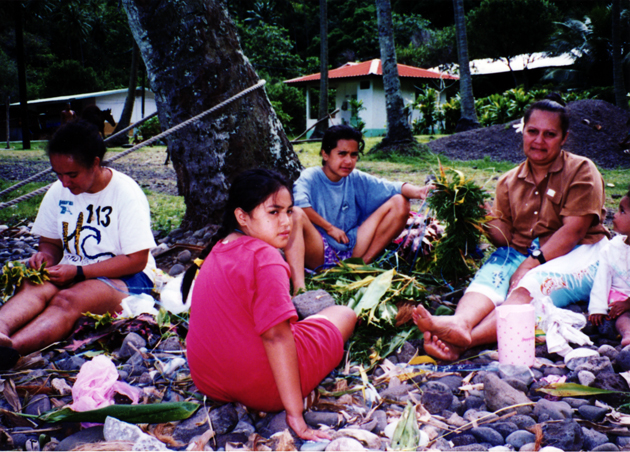
The mayor greeted us at his house, and invited us to a dinner at 7 pm.
The crew hiked up to Vai-Ee, a 100-foot waterfall at the back of the valley with some of the children. On the way we passed a petroglyph:
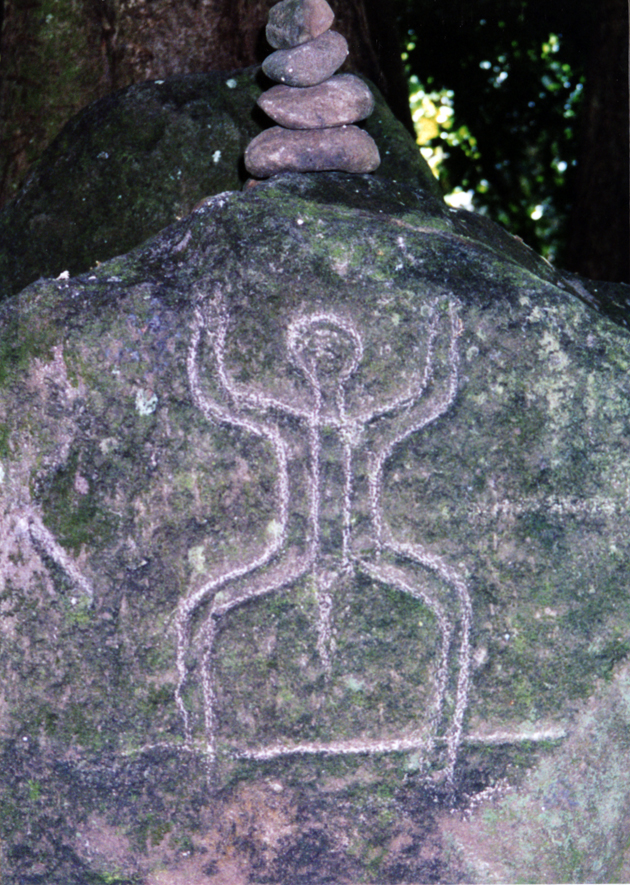
At the waterfall, some of the brave practiced the traditional Hawaiian sport of lele kawa (cliff jumping), from a ledge 40 feet above the pool.

They saw a freshwater eel swimming in the pool. (The children who came with us kept shouting, "There's an eel in the pool!")
A legend tells of Koee-iti ("small eel"), who lives under this waterfall, which feeds the large clear stream called Uiha that empties into the bay. Various versions of this legend can be found in "Von den Steinen's Marquesan Myths" (1-5):
Koee-iti (small eel), who lives under the waterfall Vai-Ee in Hanavave, went to visit Koee-nui ("large eel"). who lived in a cave beneath the waterfall of Kuenui in Taipivai (or the waterfall in Hakaui) on Nukuhiva. The small eel ate only flowers and fruit; the big eel ate pig and human flesh. The small eel boasted of his home and his food supply and lured the big eel to Hanavave. The small eel swam up the stream of Uiha; the big eel followed and got stuck. The people of Hanavave then killed the eel, cut it up, and ate it.
The story seems to record a battle between a large number of warriors of Nukuhiva in the Northern Marquesas and a small number of warriors of Fatu Hiva in the Southern Marquesas (in one version the small eel is from Tahauku on Hiva Oa, the largest island in the Southern Marquesas). The warriors of Fatu Hiva apparently ambushed the Nukuhiva warriors in the narrow valley of Hanavave. In one version, the fantastic upcroppings of rocks that line the valley of Hanavave are said to be the remains of the big eel.
Hanavave was one of few places in the Marquesas where the water is drinkable for outsiders, as it comes from a mountain spring rather than an open stream. The children of the village seemed unafraid of swimming in the clear, shallow near-shore waters of the bay; elsewhere people seems to fear the water because of the large number of tiger and hammerhead sharks that live near shore in the nearly reef-less islands.
On the way back, we met Tava, who had gone exploring on his own, wearing a headdress of leaves.

Tava picked the leaves in the valley of Hanavave, where he found the remains of ancient paepae. The leaves on the back of the headdress are 'awa.
When we returned to the bay, the children all swam out to the canoe and stayed on board, eating peanut butter and crackers.
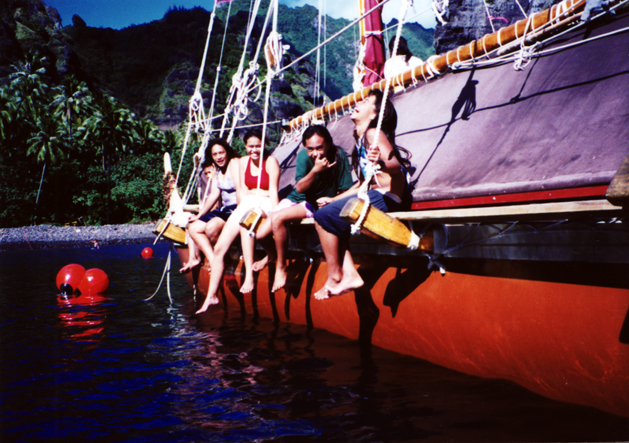
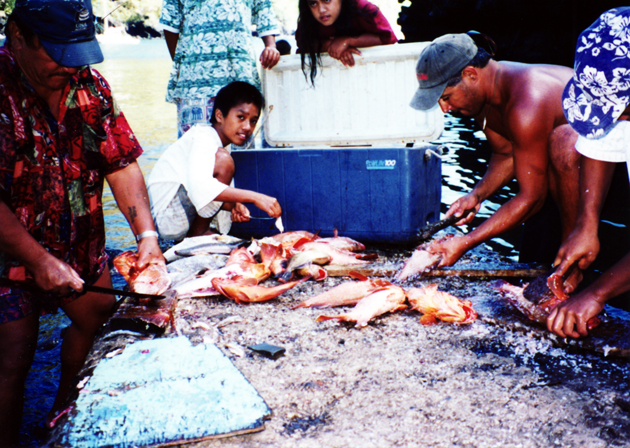
Kealoha helped wilth cleaning fish for dinner
At 6:30 the 100 or so villagers began showing up with food at some tables set up near the shore. After dinner, six musicians and about 24 dancers, men and women, boys and girls broke out in dance, the beating drums booming in the still night air; the backdrop was coconut trees, pitch black cliffs, and the Southern Cross, the Pointers, Maui's Fishhook, and the Milky Way arching above all. It was amazing what the people had put together without notice...
Hokule'a and Kamahele plan to wait in Atuona for supplies to arrive on August 10, before continuing onto Mangareva, about a 1000 miles to the south on August 11 or 12.
August 10 Hiva Oa
Atuona, Hiva Oa--The freight ship Aranui arrived in Hiva Oa at 2:00 am with supplies for Mangareva Leg and Kamaki Worthington, crew member on Kamahele for the voyage to Rapa Nui. Kamaki has been receiving the shipment of supplies in Pape'ete over the last three weeks. One shipment for the Mangareva voyage came to Hiva Oa; a second shipment to Mangareva for the voyage to Rapa Nui will leave from Pape'ete on August 13.
Hokule'a crew unloaded the supplies from the container and took them up the the house of Robert O'Connor to re-pack the food before loading it onto the canoe this afternoon and tomorrow.
Yesterday was also a work day. Crew cleaned the hulls and deck and did minor repair work. Robert & Ziella 'Oconnor hosted the crew for dinner last night. Robert is president of the Kua Moehau canoe club of Atuona.
Weather: winter rains, humid, but sometimes chilly nights; hot, humid days
Hokule'a plans to leave Atuona on August 12 or August 13.
August 12 Hiva Oa
Atuona, Hiva Oa--Hokule'a's crew finished packing the food into the hulls of the canoe. All the crew members made their last minute preparations for departure, scheduled for Saturday morning at first light.
Schedule
Thursday morning, the crew will go on a well needed sight seeing expedition to Puamau on the far eastern end of Hiva Oa. When the crew returns to Atuona in the late afternoon, the local community will conduct a farewell ceremony, which will include a dinner and dance performance by Te Pua o Feani. Friday, the crew will visit Ta'aoa, to the west of Atuona.
Weather
The weather for the past 24hrs has been poor. 90% cloud cover has dominated the sky with frequent squalls. The winds have picked-up a few knots as well, blowing in the 15-20 kt range. Accompanying this weather has been a substantial south by south-west swell. Some local kids have been taking advantage of the good surf in the bay of Atuona.
August 13 Hiva Oa
Atuona, Hiva Oa--Hokule'a plans to leave Atuona for Mangareva tomorrow morning at first light. It should take about 18 days to get there, with a stop at Pitcairn.
Apprentice navigators Moana Doi and Catherine Fuller will hold a course of SE by E for the first segment of the voyage (660 miles). They will backsight on the islands of Hiva Oa and Motane to hold the course as long as land can be seen,lining up Feki Point between Atuona Bay and Tahauku Harbor with the peak of Feani (3300 ft.) above Atuona; then the north end of Motane island and Feani once the canoe passes Motane. The rising sun will also serve as a bearing for the navigators as they depart.
The sail plan differs from the plan developed before the crew left Hawai'i. Because of light winds and a schedule that requires the canoe to reach Mangareva (via Pitcairn island) by the first week of September to prepare for the push to Rapa Nui, captain / navigator Chad Baybayan decided that instead of sailing NE by E to gain easting, the canoe will be towed SE by E into the trade winds to eliminate about 500 miles of sailing. The tow boat Kamahele will be guided without instruments from the canoe by Doi and Fuller.
At about 16 degrees S and 130 degrees W, the canoe will break the tow and head S by E for Pitcairn, about 540 miles away. At the latitude of Pitcairn (25 degrees S), the canoe will begin a search pattern, tacking SW and NW in 30 mile stints to look for the island. This second segment will be navigated by Baybayan.
Once Pitcairn has been sighted (whether or not the canoe anchors and visits Pitcairn depends on sea conditions), the canoe will head WNW for Mangareva, about 300 miles away. This last portion will be navigated by newly appointed student of navigation Aldon Kim. (A map of the new course line for Mangareva will appear at the PVS website in about a week.)
The canoe is fully loaded and prepared for departure. Yesterday the crew took a break from work to go to Puamau, on the NE coast of Hiva Oa, where the famous me'ae (heiau) of Ipona is located. Puamau mayor Bernard Heitaa gave us a tour of the grounds, which included the largest stone tiki in French Polynesia; a large, flat fish-like stone; sacrificial stone; and a flat-topped stone for preparing the inks for traditional tatoos--all beneath towering breadfruit trees and a gigantic stone cliff.
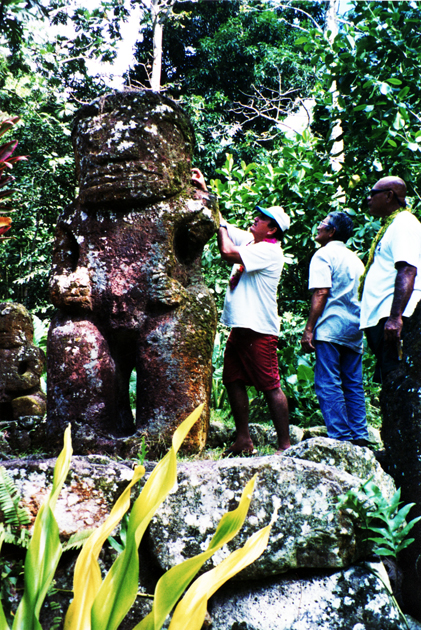
Takaii ("Powerful Belt"), the Largest Stone Tiki in French Polynesia, at the Me'ae of Ipona, Puamau, Hiva Oa. (L to R): Robert O'Connor, whose family hosted the crew in Atuona; Bernard Heita'a, the mayor of Puamau; Tava Taupu. Human sacrifices at this me'ae were made to insure the growth of ulu, or breadfruit, the staple of Marquesan diet in traditional times. Periodic droughts during which the breadfuit failed to ripen brought famine to the Islands.
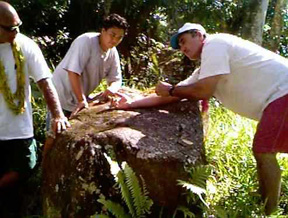
The Stone Used to Prepare Inks for Kakau (Tatoos); Ipona, Puamau. The base was oil of the kukui, which is called lama in the Marquesas where the oily nut was burned for light (cf. Hawaiian "lama": torch, light). Our host Robert O'Connor (right) demonstrates the tatooing technique.
Heitaa said that the people of Puamau believe that the people of Rapa Nui migrated there from this valley. He said that his family was not originally from Puamau, but came from a more remote valley that was abandoned when the young people left for places such a Puamau and Atuona.
The drive from Atuona to Puamau was over an unpaved proto-road, dug out and carved into the rugged Marquesan mountains and cliffs by the machines of Caterpillar, Case, Komatsu, Hyundai, Volvo, and Mercedes. Toyota 4-wheel drives rule out there. The 12-mile drive took about 3 hours. The eventual paved road will no doubt be another victory for the multinationals, determined to spread modern consumer culture into one of the wildest, remotest terrains on the planet
Last night in Atuona, a Marquesan dance group called Te Pua o Feani ("The flower of Feani peak"),under the leadership of Patrice Kaimuko, hosted the crews of Hokule'a and Kamahele for dinner and performed a revived form of Marquesan dance.
The dances were based on traditional Marquesan stories, such as Makaianui (a giant pig) and the creation of Marquesas by a man named Oatea (Hawaiian: Wakea) and a woman named Atanua.
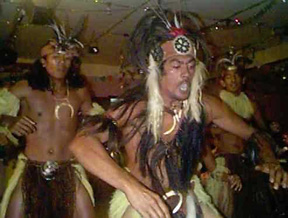

Patrice Kaimuko (left above), kumu of the Marquesan Dance Group Te Pua o Feani, leads the pig dance. He teaches to the youth of Atuona what he learned about Marquesan Dance from his mother. Raita Gramont (right above) led the female dancers of Te Pua o Feani. Raita teaches English and French at the local school and served as translator for the crew while we were in Atunoa. Raita told us a version of the Marquesan creation story, which Te Pua danced at their performance: The god Oatea and goddess Atanua built the islands as their house: Ua Pou was the posts; Nukuhiva the rafters, Hiva Oa the ridge pole; Fatu Hiva, the thatching; Tahuata, the fireplace; Ua Huka, the rubbish pit; Motane, the bird singing to the rising sun; Eiao, the rising sun. (Another version in Greg Dening's "Islands and Beaches": "Their god Atea built a house. Nukuhiva was its pointed roof, Ua Pou its support posts, Ua Huka its binding, Hiva Oa its ridge pole, Fatuiva its thatching, Tahuata the celebration of its completion," 13-14).
Reports on the journey from Hiva Oa to Mangareva (August 14-29), by various Crew Members.
August 14 / Moana Doi, departing Hiva Oa
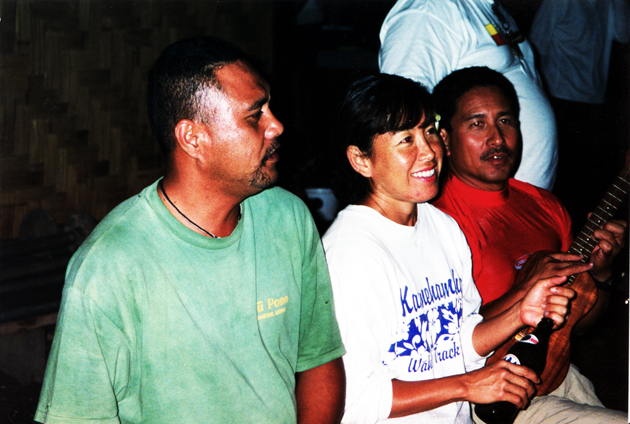
Mona, Moana, and Kaniela
Departure from Hiva Oa. Six days in Hiva Oa is enough to make you feel at home and comfortable, especially with our new friends and familiar surroundings. But today is departure day, the beginning of our longest journey to our next destination, the ending of our island hopping.
The hardest part about staying on these islands is that the longer you stay, the more difficult it is to leave. I hate good-byes , so for me today there is pain in my heart. It maybe only a short time that we've come to know these wonderful, special people, but they have touched me in ways that I will never forget.
By around 9 am, we are under tow saying our last good-byes, waving to the locals standing on the pier. Papa Robert and his wife Ziella and some of his family follow us alongside on the boat of Georges Gramont with his wife Giselle and daughter Raita and others.

Crew ready to depart from Hiva Oa
Unfortunately we will be under tow for about the next 5 days – Chad says we have to in order to meet the schedule. Sometimes schedules suck, they just get in the way. And given the light winds, we don't have much choice.
We head for the island of Mohotani, just outside of Hiva Oa, then we will use Mohotani as a backsight until sunset. A pack of 'iwa birds follow us, curious, they fly and circle above us. Tava throws lines at them in hopes for a tasty lunch. No luck: Dolphins are always a welcome sight. On our way to our next target-Pitcairn.
August 14 / Chad Baybayan
I watched the sunrise this morning and as the sun creeped above the surface of the horizon the sky was transformed into a pallet of golden hues with radiating patches of brilliant oranges. It was a quiet and simple way of heralding in the 43rd year of my life. I thank the creator for granting me a birthday present of such natural beauty and splendor.

Chad with his birthday cake from the crew
A very special and intimate way to celebrate the many experiences of my life. Once again I find myself on Hokule'a, traveling along the ancient sea roads of my ancestors. Although I am much older now and on a new and different voyage I find my spirit once again strong and very much alive. The crew, a scattering of experienced sailors mixed in with a large contingent of new crew members will provide Hokule'a with a generation of voyagers to skillfully sail her into the next millenium.
The whole voyage has been and continues to be incredibly exciting for me. Although I miss having Nainoa, Bruce, and Snake on board. I have found the experience of leading this segment of the voyage to Rapa Nui to be energinzing to my spirit and soul. I find myself confident in my decisions, fair in my judgements, positive in the beliefs that drive me, and I continue to grow stronger each day.
This crew inspires me. I remind myself that although I selected every individual aboard, I can no longer call this "my" crew, it has now become "our" crew. Including myself, this crew of 15; 11 men and 4 women, has honored me through their loyalty and support. They have been tireless in their work to prepare Hokule'a for this voyage. There is no will stronger than that of people of common belief who focus those energies in making their shared dream a reality. I love this group of strangers who are now a family. Starting with Nuku Hiva, we have visited all six of the inhabited Marquesan islands. Polyesian hospitality is alive and thriving on Nuku Hiva, Ua Pou, Ua Huka, Tahuata, Fatu Hiva, and Hiva Oa. The crew has been hosted to feasts on every island and the Marquesan community has been unselfish in sharing the local bounty of vegetables, fruits, poultry, and fish. We have been entertained with traditional Marquesan dancing. On Fatu Hiva, many of the dancers came by fishing boat from a neighboring village so that there would be a suffecient amount of dancers to entertain us. We have made countless friends in the Marquesas and the family of the canoe continues to grow.
On this voyage I am doing something I never considered doing on any previous trip. I have asked our escort boat, Kamahele and her Captain Alex Jakubenko to assist Hokule'a by towing us east and away from the dangerous reefs of the eastern Tuamotu Archipelago. It was not a decision easily arrived at. In these light winds we could attempt to tack east but it would require an enormous amount of time at sea, time which i feel would be better spent in Mangareva preparing Hokule'a for her big push to Rapa Nui. When I feel we are far enough east to safely clear the dangerous reefs of the Tuamotu's we will release the tow and begin sailing hard on the wind. Although it pains me to tow Hokule'a, I am comforted by the though that my decision is one based upon concern for the safety of crew and canoe, as well as the major objectives of the voyage. We have not compromised the ancient polynesian tradition of navigating without instruments, we issue all instructions to the escort boat as to the direction we wish to travel in.
Mangareva is our destination but Pitcairn is our target. In my planning, the tiny island of Pitcairn, 2 miles long and 1 1/2 miles wide, became a place I felt important for Hokule'a to visit on this voyage. Much like Rapa Nui, Pitcairn is very much isolated. At the end of the Tuamotu Archipelago, Pitcairn is governed by New Zealand and is a British dependent. The local community are descendants of Fletcher Christian, mutineers of the Bounty, and the polynesians who accompanied them into exile. Pitcairn is out of the way of major shipping lines and is only occasionally visited by passing yachts. How special it would be for these historic inhabitants to have the opportunity to meet the canoe and crew of Hokule'a and recognize that we share a common past linked to events in our distant maritime history. I am hoping to use our shared seafaring heritage to bridge an d build a friendship between people who are new to each other.
Sailing to Pitcairn will take us 280 miles upwind of our destination. We should be able to make a landfall on Mangareva 56hrs after departing Pitcairn.
The voyage to Rapa Nui is about honoring our common ancestors, of training a new generation of seafarers and wayfinders, and about maintaining the spirit of exploration that allowed the polynesian people to make the discoveries that its' descendants today now call home. So we sail for Pitcairn to share the canoe and ourselves with new friends and to create the richest experience tha 15 people on board the open deck of a voyaging canoe can have.
August 17
The crew yesterday scrub deck and canvas, pumped hulls as the weather was very calm. The crew is experiencing a stomach virus going around, putting 2 people a day down for 24 hrs. Some still have fever from land and a report of staph infection. Nothing serious...the normal winter cold season on the canoe.
No fish today, although a malolo (flying fish) flew into Chad's sleeping bag last night.
Birds: koa'e kea (white-tailed tropic bird), booby.
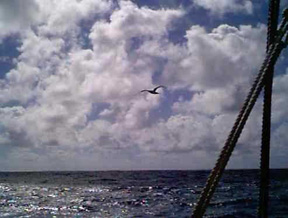
Booby bird
August 18
Cat is sick with chills, everyone else is getting better. Sea life: booby and malolo (flying fish).
August 19
Stomach flu still going around. Mel thinks it may be the water from Hiva Oa. The crew will start boiling all water today. The escort boat Kamahele has a water maker on board and has much excess water to supply Hokule'a.
August 20
Had chili for dinner, over all health is better, looking for wind.. caught 20-lb. aku, 25-lb. mahimahi; the Hokule'a crew gave half their catch to the Kamahele. It was much appreciated...
August 21
.. everyone improving, with the help of antibiotics.
Finally, after solving the stomach flu problem, all crew are 100%. They spent the majority of the day cleaning out all the sleeping compartments. At the end of the day, they crew performed a play of sorts. The first dance was about hunting a pig, the second dance was about the demi-god Maui (affectionately played by Mona Shintani).
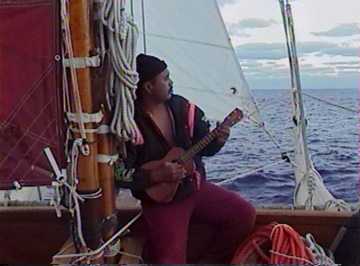
Mona Shintani. Photo by Moana Doi.
Today we talked with Tim Gilliom, a commercial fisherman and crew member from Maui. He has been learning to speak Hawaiian Language while on the voyage. Tim's mother urged him to learn his 'olelo makuahine, to bring him closer to Hokule'a and his Hawaiian heritage. His teacher on Hokule'a has been Mona Shintani, a native speaker from the island of Ni'ihau. Currently, Mona lives in Hilo were he teachs 'Olelo Hawai'i at Nawahi Immersion school. Tim's Hawaiian word for today is "Nonolo kapukaihu" meaning "to snore"... Tuesday we'll be talking to Gary Suzuki from Lana'i.
August 25 / Moana Doi, on Pitcairn
Throughout the night I could feel the toss and turn of the canoe, the sounds of the night are only those of the wind humming thru the shroud lines and filling the sail, and the water lapping up against the hulls. An occassional wave breaks on the starboard side, as the canvas gets cool, all I remember thinking is, thank God the canvas has no leaks! I could feel the canoe pick up speed, and thoughts of maybe seeing the island ofPitcairn tonight sometime, or perhaps sailing past it in the dark.
Last night's watch was probably the most challenging for me. As a student apprentice navigator under Chad Babayan, my biggest fear is disappointing him. So while he rested shortly after our watch began, my job was to hold course. Using whatever clues I had, despite the cloud cover for most of our watch, all we could do was to do our best. While I was the eyes, I had Mel Paoa, Gary Suzuki, Tim Gilliom and Nalani Wilson to steer the canoe and hold her on course.
I awoke around 4:30am to the voices of yelling and screams of joy! Gary Yuen on watch, was the first to spot land. We found Pitcairn!! Everyone came up on deck and ran up to the bow to have a look. There was the island, right off our port bow. It's a navigators dream to have the island right in front of you as you sail right to it. It could not be better. Ideally, you want the island to come to you-Chad is awsome-he's the "bomb"!
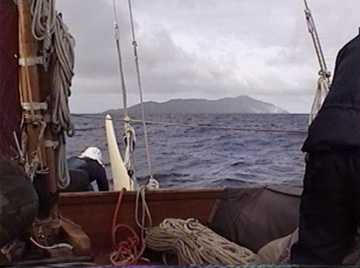
Landfall Pitcairn
I made my way from my bunk to the bow and there it was, a dim shadow in the distance. The morning was overcast and cold, passing squalls on the horizon, choppy seas, rocking and rolling-wind still out of the east. Looks like Diamond Head, or maybe Rabbit Island. My eyes filled with tears-for a moment I became overwhelmed with mixed emotions, but mostly, to feel what it feels like to find an island and see it fise up from the horizon, to know that everything you believe in, everything you work so hard for, to visualize, believe, and to make it happen.

Hokule'a was towed into Bounty Bay by Kama Hele.
Pitcairn is 2 mile sby 1.5 miles wide, much smaller than Rapa Nui. Population, 42 people a cargo ship with supplies comes every 4 months sometimes every 6 months.
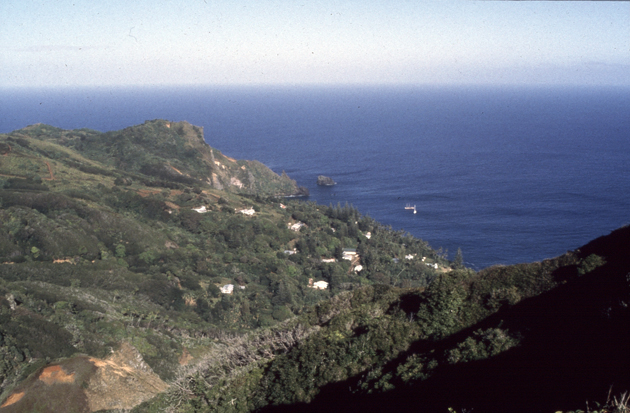
This is like a dream. I'm so happy for Chad, for us the crew-we made it! No searching, the island cam to us. It was awesome!
Our breakfast is saimin, another staple food and an easy meal to prepare on the ocean--and great for cold mornings like today. We head for Pitcairn, hook up our tow line and anchor inside Bounty Bay. The island is lush, plenty of Manu O Ku flying about, palm trees, steep cliffs, blue water.
A woman fishing in a kayak comes to greet us; the Mayor, Jay Warren, comes by way of a aluminum boat to shuttle us in to land. Greeted by the local islanders, they invite us to their homes for a shower, and ice water, the two things I enjoy most when first coming to land. Not too many people can say they've been to Pitcairn!!
Our host family for Kat, Nalani and I is Thomas and Betty Christian. Betty takes us on a tour of the island by way of a 4 wheel drive quad-the only means of transporation on the island. No cars, just the 4 wheel drive quads. You even see the 60 year old "tutus" driving them around. Pretty cool.
Pitcairn has some amazing scenic spots, a tiny little island in the middle of a great big ocean which surrounds you every way you look. What it would be like to live on a tiny island, totally self sufficient, life is simple. The people here are totally content, happy, no desire to venture to the rest of the world. I don't blame them. They have everything they need right here. The island and its people are truly a gem. How lucky we are to be here!
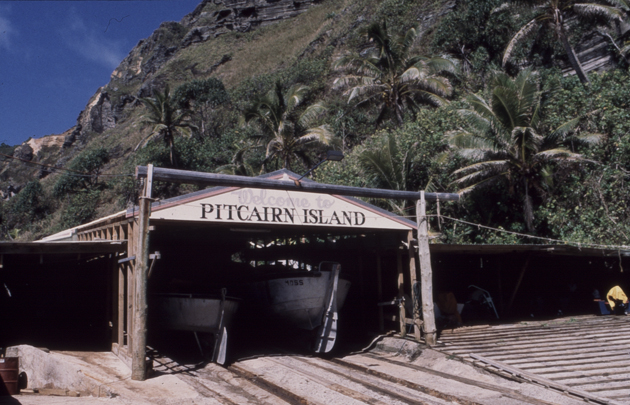

August 24 / Cat Fuller, via Sat Phone; arriving on Pitcairn
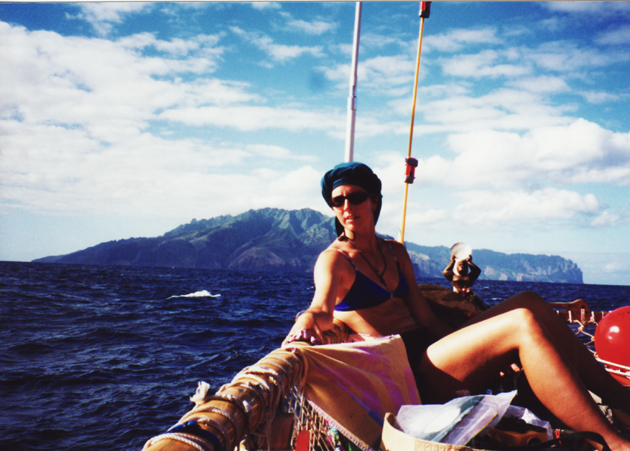
Cat Fuller
Hokule'a is anchored about 100 yard off Pitcairn Island on the NE side in Bounty Bay; the crew was ashore by 11:30 a.m. HST. After a couple of days and nights of squally weather (navigating by the moon, winds and swells), crew member Gary Yuen sighted Pitcairn directly off the bow of the canoe at sunrise this morning. The canoe was under sail, having dropped its tow line at 4:30 yesterday afternoon.
The crew spent the morning anchoring the canoe in sunny weather and light westerly winds. (Good wind for sailing to Rapa Nui!) The island is mostly high cliffs, thickly vegetated, and the anchorage deep and clear. You can see the anchor 43 ft. down. There are about 12 buildings in Adamstown, perched on the cliff above the bay; population is about 57, many of them the descendants of Fletcher Christian and the other mutineers of HMS Bounty and their Tahitian wives.
Because the anchorage is unprotected, the crew plans to leave by tomorrow evening. They are hoping for northerly winds to follow the westerlies as the cold front causing the westerlies moves to the east; the northerlies would allow them to sail to Mangareva, about 290 miles WNW of Pitcairn. If the westerlies persist, the canoe will be towed. ETA in Mangareva is Saturday. Newly appointed student navigator Aldon Kim, with Moana Doi and Catherine Fuller, will be guiding the canoe for the final segment of the voyage to Mangareva.
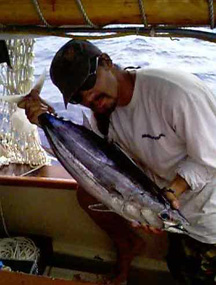
Aldon with aku
A new crew for the voyage to Rapa Nui, including navigators Nainoa Thompson and Bruce Blankenfeld, will be leaving Hawa'i for Mangareva on September 11. The two navigators will join navigator Chad Baybayan in Rikitea, Mangareva, to prepare for the push to Rapa Nui, to begin in mid-September.
Crew status: Everyone is feeling fine, ecstatic over landfall...the crew decided it wasn't the water from Hiva Oa that was causing the upset stomachs and chills, as some crew members who drank the water didn't get sick. Probably a bacterial infection; antibiotic got everyone healthy again.
August 26
At 8pm HST Hokule'a departed Pitcairn Island for Mangareva.
The crew will, in the next 2 days, be cleaning and preparing the canoe for arrival in Mangareva.
Yesterday, prior to departure, the crew of Hokule'a and Kamahele put on a lu'au for the entire island of Pitcairn (population 42). Tim Gilliom spent the morning fishing for the feast. He caught one 40 lbs. 'Ono, two 50 lbs. Ahi, and an Aku, all in 1 hour (only about 200 yards off shore).
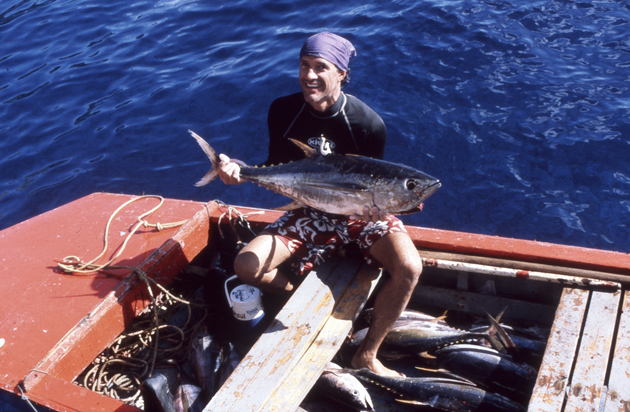
Tim with ahi
The fish was prepared by Mel Paoa, Gary Suzuki, Gary Yuen, and Aldon Kim. They made ahi poke, poisson cru (Tahitian-style raw fish), dried aku, and fried the 'ono.
While the crew were getting dinner ready, Navigator Chad, Apprentices Moana and Cathrine, and crew members Aeroway and Nalani went to the islands only school to talk to the students about Hokule'a and navigation. They were received warmly by the 10 students of the school, and sang a song. After the presentation, the crew members gave the children some M & Ms, and other chocolates. This was indeed a real treat for them since the island was without chocolate for 3 months. Pitcairn gets a shipment of supplies every 4 months from New Zealand. Chocolate is usually the first item to go.
After dinner, the island community transported the crew down the steep cliffs on 4 wheel ATV motorbikes (no cars on the island just the ATVs) and saw the Hokule'a and Kamahele off. Only the sound of the Pu (from crew member Atwood Makanani) could be heard as the two vessels sailed into the quiet night.
August 27
Today, we interviewed crew member Gary Suzuki, from Lana'i. Gary is one of the hardest working crew members on Hokule'a. He's always helping others and has a lot of energy; "To be on Hokule'a for me is an honor. I feel I'm very lucky to be here, so I try to do my very best. Hokule'a sails for all Hawai'i Nei".
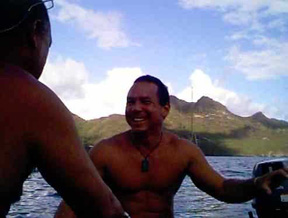
Gary Suzuki
August 28
At approximately 1 pm HST, the navigators Catherine Fuller, Moana Doi, and Aldon Kim sighted the small atoll of Te Moe some 20 miles off the starboard bow. A very small spec on the horizon, Te Moe was exactly where the navigators though it would be. In the next few hours, they will be looking for Mangareva another 30 miles northwest of Te Moe.
August 29 Sighting Mangareva
At sunset, Mangareva was sighted off the starboard bow of Hokule'a by the three navigators--Cathrine Fuller, Moana Doi, and Alden Kim.

Hokule'a approached Mangareva under a bright moon (La'aukukahi, 18 days old). Photo by Moana Doi
Hokule'a then began towing to Mangareva as it was directly into the wind. Momentarily, (8:08 a.m. HST on August 29), Hokule'a and Kamahele will dock at Rikitea village on Mangareva. As of 7:15 a.m. HST the two vessels were piloted into the pass of the atoll by a fishing boat.
Mangareva is one of 5 islands, around a large lagoon. The highest point on Mangareva is about 1447 ft about sea level.
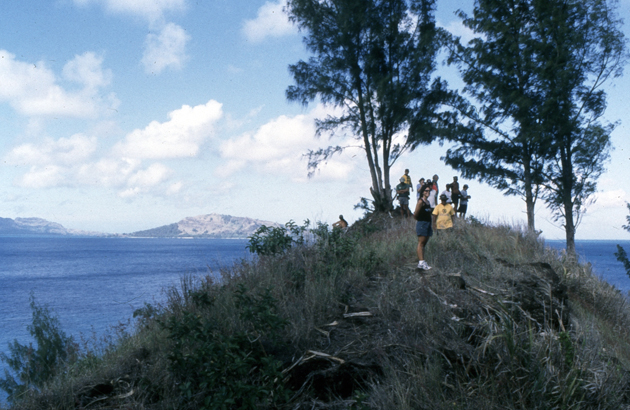
The crew hiked up to the highest point on Mangareva, the peak of Mount Duff (1447 feet). Photo by Moana Doi
With its mountainous terrain and grassy platueaus, Mangareva is one of the three populated islands. The depth inside the lagoon is 80 ft. Mangareva is becoming known for its pearl farms. Today, there is one other vessel, the cargo ship "Taporo," anchored at Mangareva.

